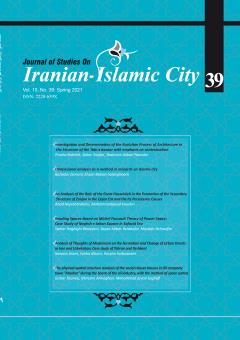An Analysis of the Role of the Great Hosseinieh in the Formation of the Secondary Structure of Zanjan in the Qajar Era and the Its Persistence Causes
Subject Areas : Islamic urbanism
Ahad Nejadebrahimi
1
![]() ,
MohammadJavad Heydari
2
,
MohammadJavad Heydari
2
1 -
2 - Islamic Art University of Tabriz
Keywords: secondary structure, great Hosseinieh, Zanjan city, Great Hosseinieh,
Abstract :
The government found more religious convergence with the people in the Qajar era. Because, in addition to the people, the government was also active in constructing religious places, such as Dolat (government) and Nasiriyah Tekyeh in Tehran and Zanjan city. This factor not only increased the influence of the Shi’i religion and publicized its religious rituals, but, in addition to influencing the physical organization of the city, it paved the way for another structure too. This structure was not defined by physical element such as the main structure. Contrary to the main structure, this structure was a symbolic and semantic that arose as a result of social action. This structure was a result of citizen’s image of mind of the urban spatial sense and identity that the social construction (religious behavior of citizens) has played a major role in its shaping and, contrary to the main structure of the city, has undergone a change. The purpose of this research is to explain the role and influence of the Hosseinieh Azam (great Hosseinieh) in the formation of the secondary structure of Zanjan in the Qajar era. The research method is historical, descriptive and analytical. Documentary and field study method has been used in gathering the required information. Results of this research showed that the construction or development of the great Hosseinieh and the formation of its mourning group in the Qajar era have played an important role in creating the secondary structure of the city of Zanjan. A structure that has persistence to this time.
امینزاده، بهرام (1386)، «بازشناسی اثر آیینهای جمعی بر پیکرهبندی شهر سنّتی؛ مطالعهی موردی: سمنان»، نشریّهی هنرهای زیبا، شمارهی 32.
اهری، زهرا (1394)، «شناسایی ساختار ثانویّه شهر ایرانی در دورهی قاجاریّه»، نشریهی هنرهای زیبا - معماری و شهرسازی، دوره 20، صص 34-23.
بینشیفر، فاطمه (1394)، «سیر تحوّل روضه و روضهخوانی دوره قاجار»، تاریخنامه خوارزمی، سال سوم، 72-47.
پاکزاد، جهانبخش (1386)، مبانی نظری و فرآیند طرّاحی شهری، تهران؛ انتشارات شهیدی.
ثبوتی، هوشنگ (1377)، تاریخ زنجان؛ زنجان، انتشارات زنگان.
حسینیکومله، مصطفی و ستودهعلمباز (1392)، «نقش خاطرهی جمعی در باززندهسازی بافتهای شهری: ارائهی راهکار در خصوص ناحیهی تاریخی لاهیجان»، نشریه هنرهای زیبا، معماری و شهرسازی، دوره 18، شماره 4، صص 92 - 79.
دوسرسی، کنت (1362)، ایران در 1839 – 1840م (1256-1255 ه.ق)، ترجمهی دکتر احسان اشراقی، تهران، مرکز نشر دانشگاهی.
دوهوسه، لوئیامیل (1858م)، سفری به ایران (مجموعهای از نقّاشیهای لوئی امیل دوهوسه)، به کوشش: منوچهر فرمانفرمائیان، 1238 - 1236.
راپاپورت، آموس (1366)، منشأ فرهنگی مجتمعهای زیستی، ترجمهی راضیه رضازاده، انتشارات جهاد دانشگاهی، دانشگاه علم و صنعت.
رضایــیقلعــه، مریــم و رمضانــی، مریم (۱۳۹۳)، «تأثیــر آیین محرم بر کالبد شــهر ســنتی در دورهی معاصر(مــورد مطالعــه: شــهر آران و بیــدگل)»، پژوهشهــای منظر شهر، شماره ۲.
رضویپور، مریمسادات و ذاکری، محمّدمهدی (1392)، «بررسی مقایسهای حسینیههای دورهی قاجار در مازندران و اصفهان»، فصلنامهی مطالعات شهر ایرانی- اسلامی، شمارهی چهاردهم، 73-63.
سلطانی، علی؛ زرگریمرندی، ابراهیم؛ نامداریان، احمدعلی (1391)، «شکل گیری، تقویت و مانایی خاطره در فضاهای شهری، نمونه موردی: محور شهید چمران شیراز»، فصلنامه مسکن و محیط روستا، شماره 141، صص 98-78.
سلطانی، رامین (1379)، تاریخ زنجان؛ زنجان، انتشارات نیکان کتاب.
سولتیکف، الکسیس،(1365) مسافرت به ایران؛ ترجمهی محسن صبا، تهران، انتشارات علمی و فرهنگی.
علیمردانی، مسعود؛ مهدوینژاد، جمالالدین و افهمی، طلیعه (1394)، «رشد کیفی فضای شهری به منظور ارتقاء تعاملات اجتماعی»، دوفصلنامهی هنرهای کاربردی، شماره 7، صص 14-5.
علیالحسابی، مهران و پایکن، عصمت (1392)، «تدوین چارچوب مفهومی تعامل شهر و آیینهای جمعی و بررسی مصداق آن در آیینهای عاشورایی»، فصلنامهی مطالعات شهر ایرانی-اسلامی، شماره دوازدهم،صص 44-27.
علیالحسابی، مهران؛ رضازاده، راضیه و چربگو، نصیبه (1396)، «ارایهی مدل مفهومی معنای مکان و شاخص های تداوم آن (تحلیل پدیدارشناسانهی تفسیری تجربیات زیسته افراد)»، فصلنامه باغ نظر، سال چهاردهم، شماره 52، صص 26 - 17.
گلکار، کورش (1382)، از تولّد تا بلوغ طرّاحی شهری، نشریهی علمی-پژوهشی صفّه، شماره 36.
گلکار، کورش (1378)، کندوکاوی در تعریف طرّاحی شهری، تهران، مرکز مطالعات و تحقیقات شهرسازی و معماری ایران.
متّقی، حسین (1382)، گلگشت؛ سیمای استان زنجان از منظر سیّاحان و سفرنامهنویسان، قم: انتشارات کتابخانه عمومی آیتاله مرعشی نجفی.
محمّدپور، احمد و شاهیزاده، رامین (1390)، «مطالعهی مردم شناختی مراسم عاشورا در شهر اردبیل»، مجلّهی مطالعات اجتماعی ایران، دورهی پنجم، شماره 3، صص 146-126.
مشکینی،ابوالفضل (1370)، بررسی سیر تکوینی شهر و شهرنشینی در زنجان؛ تهران، دانشگاه شهید بهشتی، پایاننامه کارشناسی ارشد.
وامبری، آرمینیوس (1372)، زندگی و سفرهای وامبری؛ دنبالهی سیاحت درویشی دروغین، ترجمهی محمدحسین آریا، تهران، شرکت انتشارات علمی و فرهنگی، چاپ اول.
هال، ادوارد (1376)، بُعد پنهان، تهران، انتشارات دانشگاه تهران، چاپ اول.
یوسفی، یوسف؛ آزاد، میترا؛ سلطانیمحمّدی، مهدی (1393)، «مطالعهی چگونگی ارتباط مراسم آیینی عزاداری ایام محرّم و شهر نایین»، فصلنامهی مطالعات شهر ایرانی - اسلامی، سال هشتم، شمارهی 29، صص 50-37.
Appleyard, Donald (1970), “Styles and Methods of Structuring a City”, in Environment and Behavior, vol. 2 No.1, pp 100-117.
Alexander, Cristopher (1987), A new theory of urban design, Vol. 6, Oxford University Press.
Bacon, Edmund. N (1967), Design of City, Thames and Hudson, London.
Crane, David A (1960), “The City Symbolic”, Journal of the American Institute of Planners (JOPA), Volume 26, Issue4, pp280-292.
Kheirabadi, Masoud (2000), Iranian Cities: Formation and Development, Syracuse University Press, USA.
Lang, Jon (1995), The Human Dimension of Urban Design, Urban Futures, No. 17, pp 25-36.
Masoudi Nejad, Reza (2013), The Discursive Manifestation of Past and Present through the Spatial Organization of the Ashura Procession, in Space and Culture, DOI: 10.1177/1206331213475747.
Rossi, Aldo (1982), The Architecture of the city, Cambridge, the MIT Press, Cambridge, Massachusetts and London, England.
Tange, Kenzo (1970), Architecture and Urban Design, Verlag Fur Architekture Artemis Zurich.
www.haz.ir.


